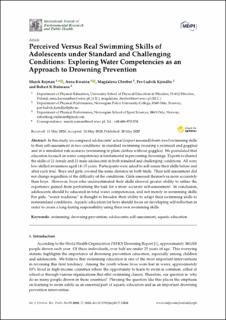| dc.contributor.author | Rejman, Marek | |
| dc.contributor.author | Kwaśna, Anna | |
| dc.contributor.author | Chrobot, Magdalena | |
| dc.contributor.author | Kjendlie, Per-Ludvik | |
| dc.contributor.author | Stallman, Robert Keig | |
| dc.date.accessioned | 2020-10-20T14:20:33Z | |
| dc.date.available | 2020-10-20T14:20:33Z | |
| dc.date.created | 2020-09-21T14:13:15Z | |
| dc.date.issued | 2020 | |
| dc.identifier.citation | International Journal of Environmental Research and Public Health. 2020, 17(11), 3826. | en_US |
| dc.identifier.issn | 1661-7827 | |
| dc.identifier.uri | https://hdl.handle.net/11250/2683982 | |
| dc.description | This is an open access article distributed under the Creative Commons Attribution License which permits unrestricted use, distribution, and reproduction in any medium, provided the original work is properly cited. | en_US |
| dc.description.abstract | In this study, we compared adolescents’ actual (expert assessed) front crawl swimming skills to their self-assessment in two conditions: in standard swimming (wearing a swimsuit and goggles) and in a simulated risk scenario (swimming in plain clothes without goggles). We postulated that education focused on water competencies is fundamental in preventing drownings. Experts evaluated the skills of 21 female and 21 male adolescents in both standard and challenging conditions. All were low-skilled swimmers aged 14–15 years. Participants were asked to self-assess their skills before and after each trial. Boys and girls covered the same distance in both trials. Their self-assessment did not change regardless of the difficulty of the conditions. Girls assessed themselves more accurately than boys. However, boys who underestimated their skills showed greater ability to utilise the experience gained from performing the task for a more accurate self-assessment. In conclusion, adolescents should be educated in total water competencies, and not merely in swimming skills. For girls, “water readiness” is thought to broaden their ability to adapt their swimming skills to nonstandard conditions. Aquatic education for boys should focus on developing self-reflection in order to create a long-lasting responsibility using their own swimming skills. | en_US |
| dc.language.iso | eng | en_US |
| dc.subject | swimming | en_US |
| dc.subject | drowning prevention | en_US |
| dc.subject | adolescents | en_US |
| dc.subject | self-assessment | en_US |
| dc.subject | aquatic education | en_US |
| dc.title | Perceived versus real swimming skills of adolescents under standard and challenging conditions: Exploring water competencies as an approach to drowning prevention | en_US |
| dc.type | Peer reviewed | en_US |
| dc.type | Journal article | en_US |
| dc.description.version | publishedVersion | en_US |
| dc.rights.holder | © 2020 by the authors | en_US |
| dc.source.pagenumber | 14 | en_US |
| dc.source.volume | 17 | en_US |
| dc.source.journal | International Journal of Environmental Research and Public Health | en_US |
| dc.source.issue | 11 | en_US |
| dc.identifier.doi | 10.3390/ijerph17113826 | |
| dc.identifier.cristin | 1831713 | |
| dc.description.localcode | Institutt for fysisk prestasjonsevne / Department of Physical Performance | en_US |
| dc.source.articlenumber | 3826 | en_US |
| cristin.ispublished | true | |
| cristin.fulltext | original | |
| cristin.qualitycode | 1 | |
